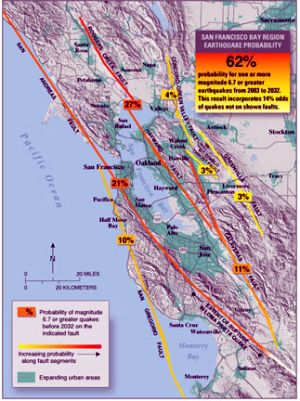Secondly, earthquake magnitude can be hard to guess because it is measured on a logarithmic, not linear, scale. In other words, when a quake is 3.0 on the Richter scale, it isn't merely three times stronger than a 1.0 earthquake. It's actually 100 times stronger. Each whole number on the Richter scale is an order of magnitude bigger than the previous whole number. Thus a 2.0 quake is ten times stronger than a 1.0 quake, and a 4.0 earthquake is 1,000 (1x10x10x10) times stronger than a 1.0 earthquake. Likewise, a 7.0 quake is a million times (106) stronger than a 1.0, which is why it can be so hard to guess actual size.
Unfortunately, there is a high probability that a 7.0 earthquake will hit the Bay Area in the next twenty years. Its source will be the Hayward Fault, one of the branches of the San Andreas Fault. The last time there was a major quake on the Hayward Fault was in 1868. It was known as the "Great San Francisco Earthquake", until S.F. was hit by a major quake from the San Andreas Fault in 1906.
A quake of a magnitude of 7.0 is immensely powerful. When it hits, it will cause major structural damage. The Loma Prieta earthquake, in 1989, was between a 6.9 and 7.1. It wiped out large sections of freeway, and caused all sorts of problems that affect Bay Area residents to this day.
Regrettably, there isn't much scientists can do to accurately predict earthquakes. They have even tried observing the abnormal behavior of animals. But studies done in the 1970's, by the United States Geological Survey, found there is no evidence that this was a reliable predictor. As a result, the USGS has not devoted further resources to similar studies.
Maybe someday we'll figure out how to predict earthquakes, but in the meantime I'm going to get serious about that disaster preparedness plan that I keep putting off. Really I will.
 Donovan Rittenbach is the Web Manager for the California Academy of Sciences. He has a Master's Degree in Multimedia, and 12 years of web & multimedia industry experience.
Donovan Rittenbach is the Web Manager for the California Academy of Sciences. He has a Master's Degree in Multimedia, and 12 years of web & multimedia industry experience.
 Geologists say it's likely that a major earthquake will hit
Geologists say it's likely that a major earthquake will hit